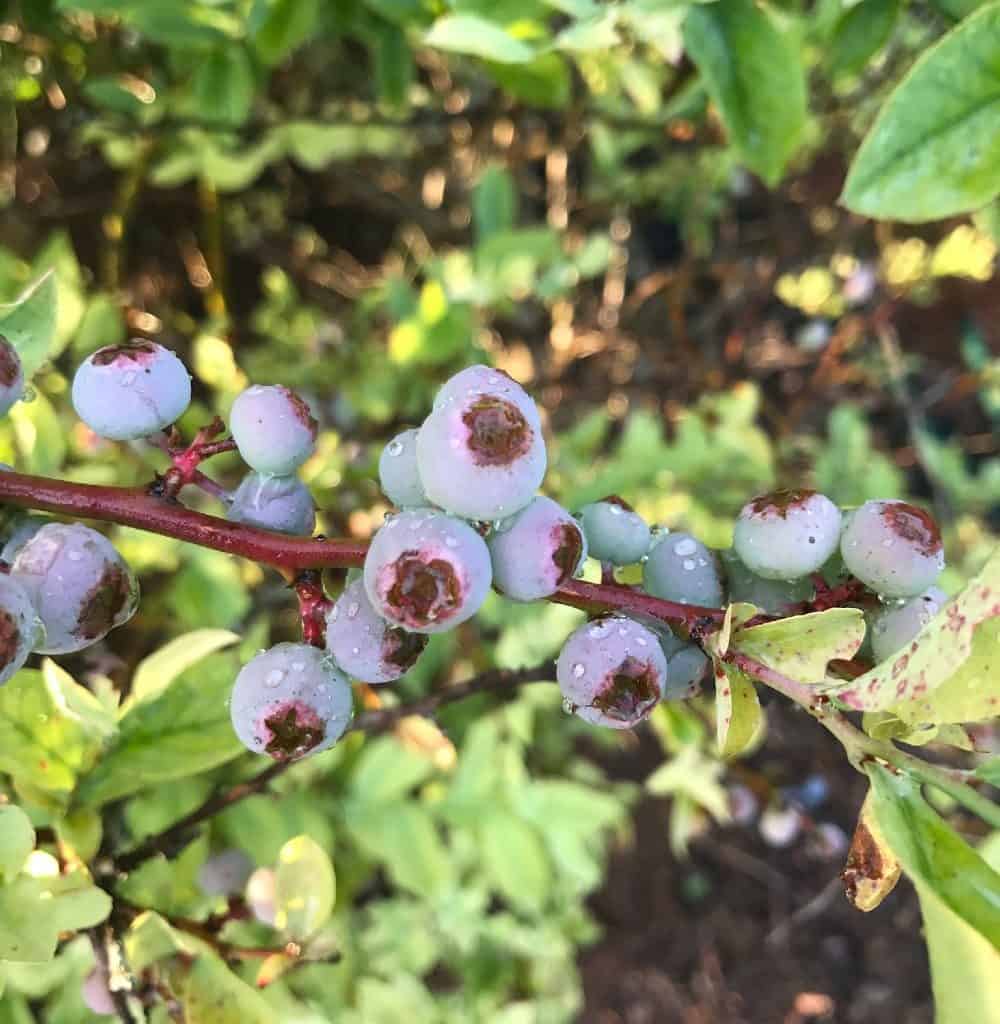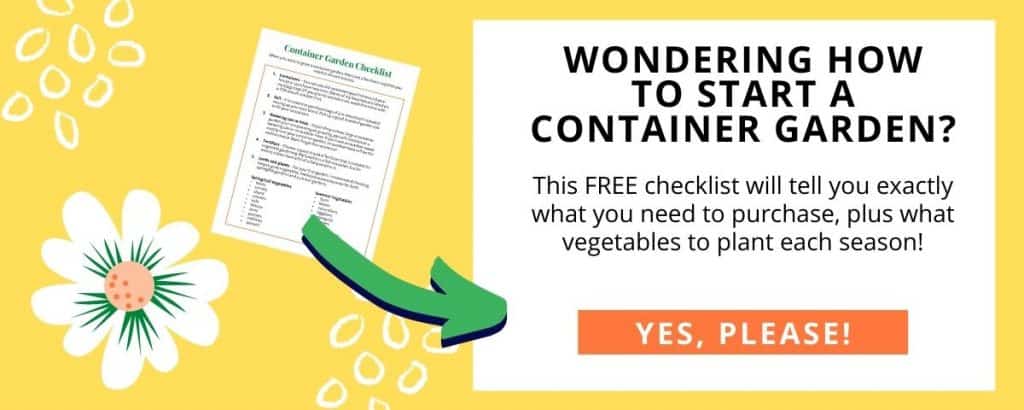The Complete Guide to Growing Blueberries
Preview: Growing blueberries is rewarding for the backyard gardener. Blueberry bushes can be grown in the garden, in a container, or as a landscape plant.
Why Grow Blueberries?
Growing blueberries is always a great idea because, well… blueberries. Nothing beats the taste of homegrown fruit. However, blueberries also make a great landscape plant. The flowers provide beauty in the spring, but their fall foilage is unbeatable. Many blueberry bushes have leaves that turn a brilliant reddish-maroon in the fall so they provide color in the landscape. Other varieties turn bright orange with the changing seasons.

Affiliate Disclosure: Please note that some of the links in this article may be affiliate links and I may receive a small commission if you purchase something through a link. It will not change your cost. As an Amazon Associate, I earn from qualifying purchases. For more information, see my disclosures page.)
What Type of Blueberries Should I Grow
There are quite a few types of blueberries and you should choose the right type for your gardening zone.
Lowbush varieties only grow 1 to 2 feet in height and are best grown in zones 3-6. Half high varieties grow 3-4 feet tall and are best suited for zones 3 to 5. High bush blueberries grow best in zones 4 to 7, growing between 4 to 7 feet. Gardeners in the warmest zones (7-10) might like rabbiteye blueberries. These are the tallest blueberries and can reach from 10-15 feet high.
How to Grow Blueberries
Blueberries grow best in full sun, so select an area that gets sun at least 3/4 of the day. A little shade late in the day won’t hurt. Blueberries need acidic soil with a pH of about 5.0 (If you don’t know your soil’s pH, here’s how to get it tested.) You can add soil acidifier to the planting area to help lower the pH. (This is the same stuff you use to turn hydrangeas blue. ?)
Blueberry bushes have shallow roots, so they need to be well watered but the soil also needs to drain well. Blueberries won’t do well sitting in water. If the area you are planting doesn’t have good drainage, you dig a shallower hole to raise the plant above the ground. Hill the soil around the blueberry bush, keeping in mind, the soil should just cover the plant at the same depth it was in the pot.
To get the best blueberry harvest, you should plant at least two blueberry bushes of differing varieties. The bushes should be spaced 4 to 8 feet apart unless you are growing the blueberries as a hedge row. Grown as a hedge, they can be planted about 2 1/2 feet apart. As an added bonus, when planting multiple varieties, the bushes often ripen at different times, thus extending your harvest.

How to Plant Blueberry Bushes
When planting blueberries, they adjust best if planted in the spring or fall, with fall being the optimal time. Dig a hole so that the blueberry bush will be at the same depth as it was in the container you purchased it in.
Remove the plant from the container and rough up the roots a bit, especially if it is root-bound. Place the bush in the hole and cover with soil to the same depth it was in the pot. Apply 2 to 4 inches of mulch. (No redwood or cedar.) Fertilize in the spring with an acid fertilizer such as an azalea or rhododendron blend. Blueberry bushes can also be fertilized with blood meal or cottonseed meal according to package directions. Do NOT over fertilize. Fertilizing with manures is also NOT recommended as they can damage the plants.
Blueberries can live for 40-50 years so choose your location carefully before planting.
Protecting the Fruit
Of course, people aren’t the only things that like blueberries. Birds and other critters enjoy them too. As blueberries get ripe, the birds will gladly steal your harvest. (So will the chickens if you allow them to free range near your bushes. ?) The simplest way I’ve found to keep the birds out is to gently drape bird netting over the blueberries. I find it best to wait until the berries have developed and are starting to get ripe. Otherwise the bushes will grow into the netting and you’ll have a hard time getting it off without losing lots of berries.

Picking Blueberries
Blueberries are really easy to pick. They are ripe when they turn from a reddish tint to purple. However, I’ve found it easiest to just taste a few, checking the color before tasting. Not all blueberries on the bush will be ripe at once, so you can usually harvest them over a 2 week period or so. They freeze great so storing extras shouldn’t be a problem.
Pruning & Fertilizing Blueberry Bushes
After the first 3 years, blueberry bushes need to be pruned yearly. You can prune them in late winter/early spring just before they leaf out. They can also be pruned in the summer after they have produced fruit. To prune blueberries, remove the low growth near the ground. Also remove any dead wood and any branches that are over 2 inches in diameter. To keep the plants healthy, cut out any short or discolored branches too. For a video on how to prune blueberries, check out this video from Melissa K. Norris.
If you notice yellowing leaves, that can often be an indication of a nitrogen deficiency so fertilize with a high nitrogen fertilizer. Fertilizing with some compost each year will help provide blueberries with added nutrients too.
Growing Blueberries in Containers
Blueberries do quite well in containers as long as you keep them from drying out. When selecting containers, get the largest ones you can afford. This will keep you from having to water as frequently. Choose lighter colored containers so the roots don’t get as hot during the summer.

When choosing blueberries for containers, choose dwarf, Lowbush, or half high types. Most experts also recommend picking a variety that grows best one zone lower than your current zone. (Since the roots will be exposed to the elements more than in-the-ground plants.) The best varieties for containers include Patriot, Northsky, Top Hat, and Sunshine.
When planting the blueberry bushes, follow the same procedure as above for roughing up the root ball. Be sure to mix some soil acidifier into the potting soil to lower the pH. Keep the soil in the containers moist but not overly wet.
If you live in a cold climate, it is best to move the container grown blueberry bushes into an unheated garage or building for the winter. If that is not an option, move the plants to a sheltered location away from the wind.
Have you ever grown blueberries?
Have you ever grown blueberries? If so, I would love to know your favorite varieties and what zone you are growing your blueberries in. Leave a comment below and let me know. And if you enjoyed this post, I would love it if you would pin it for later.

